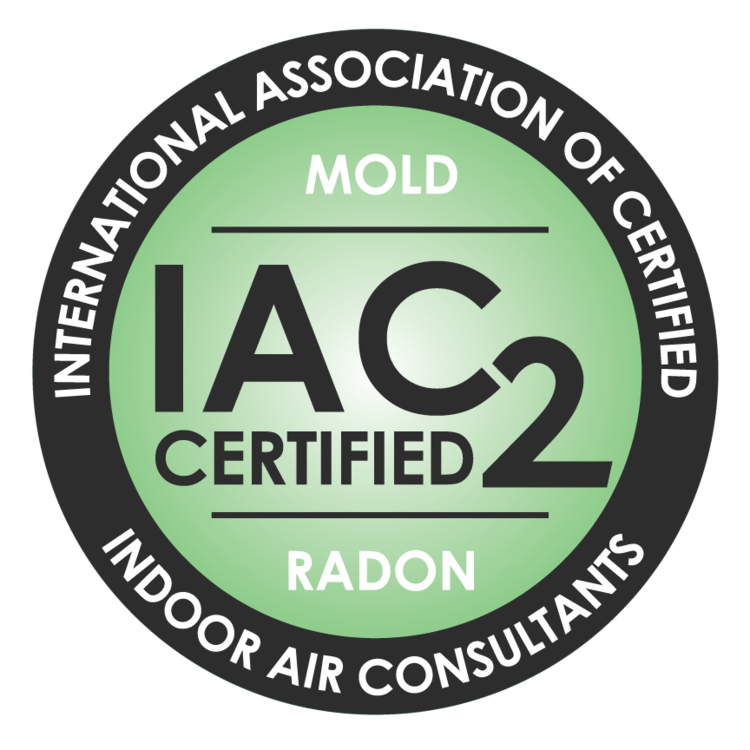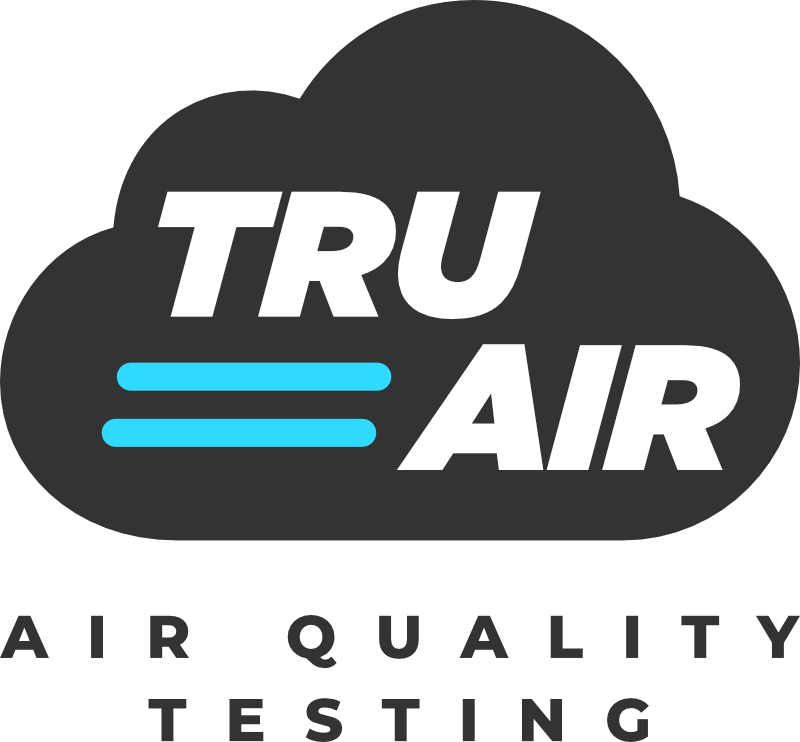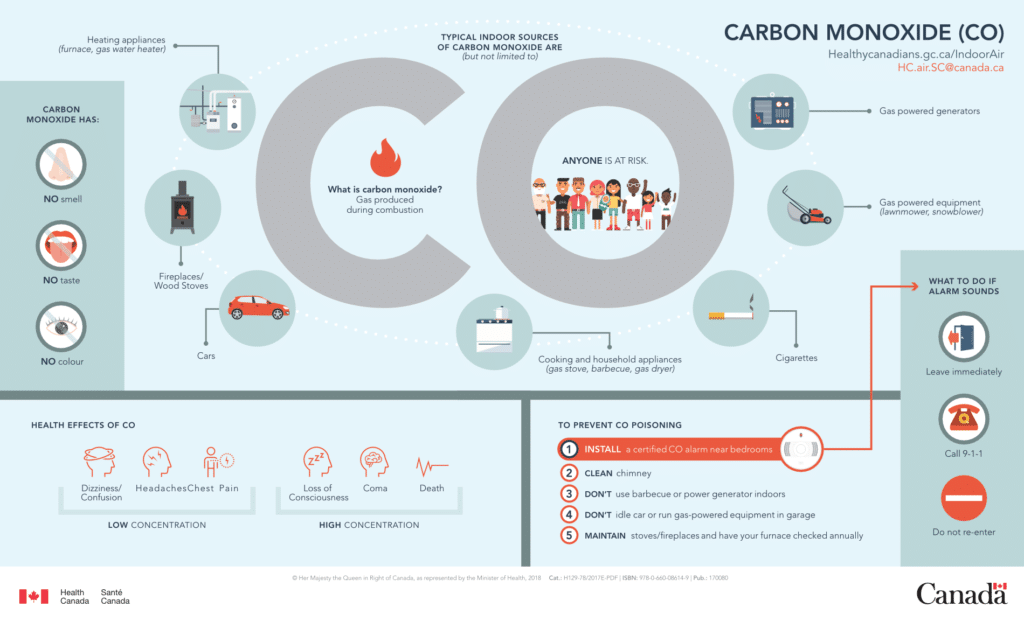General Air Quality Testing
Your Local Air Quality Experts.
We can conduct general air quality testing that will measure several different air quality threats. Here's more information on just a few:
Table of Contents
Carbon Monoxide (CO)
Excerpt from the Government of Alberta
How it’s produced
Carbon monoxide is produced by the incomplete burning of common fuels. This happens when there is not an adequate supply of oxygen. Common fuels include:
- gasoline
- diesel
- coal
- natural gas
- propane
- heating oil
- kerosene
- any other combustible material such as wood, cloth or paper
Potential sources
These are potential sources found in your home, camper, garage and workspace:
- fireplaces
- clogged chimney flues
- water heaters
- furnaces
- gas space heaters
- wood and gas stoves
- generators
- tobacco and cannabis smoke
- vehicle exhaust, especially from attached garages or vehicles parked close to ventilation intakes
Signs and symptoms
Health effects vary depending on a person’s age and pre-existing medical conditions, the amount of carbon monoxide in the air and the length of exposure. Exposure can cause headaches, confusion, dizziness, weakness, nausea and other flu-like symptoms. In severe cases, exposure can lead to abdominal pain, diarrhea, impaired vision, convulsions, coma and potentially death. If you have symptoms that you think could be caused by carbon monoxide poisoning, leave the area immediately, and call 911 or go to the emergency room.
Reducing the risk
Reduce the risk of carbon monoxide poisoning by ensuring your appliances are regularly maintained and properly ventilated.
- Fuel-burning appliances, such as furnaces, stoves and fireplaces, as well as chimneys and vents should be cleaned and inspected every year before cold weather sets in.
- Vents for fuel-burning appliances should always be clear of debris.
- Gas and charcoal barbeques should be used outside, away from all building openings.
- Portable fuel-burning generators should be used outdoors in well-ventilated areas away from building openings.
- Portable fuel-burning heaters should be vented properly, according to the manufacturer’s instructions.
Other ways to reduce the risk include
- Never using the stove or oven to heat your home.
- Open the flue for adequate ventilation before using a fireplace.
- Never run a vehicle, fuel engine or motor inside a garage, even if the garage doors are open.
- Always remove a vehicle from the garage immediately after starting it.
Carbon monoxide alarms
Buying an alarm
Alarms are inexpensive and can be purchased from most hardware, department and electronics stores.
Ensure a recognized certification body, such as Underwriters Laboratories of Canada, Underwriters Laboratories or the Canadian Standards Association, has approved and labelled your alarm.
All alarms have an expiration date and need to be replaced once they have expired.
What to do if the alarm sounds
Follow the steps below if you or anyone in your home is suffering from symptoms of carbon monoxide poisoning.
- Get everyone out of the home immediately.
- Call 911 or your local emergency services number from outside the building.
- Do not return home until an official advises it is safe to do so.
If your alarm sounds and no one is suffering from symptoms of carbon monoxide poisoning, check to see if the battery needs replacing or the alarm has reached its end-of-life before calling 911.
Testing and replacing the alarm
- Alarms should be tested monthly by pressing the test button.
- Replace batteries every year.
- Replace alarms according to the manufacturer’s instructions.
Know the sound of the alarm
Carbon monoxide alarms sound different from smoke alarms. Test both alarms monthly and make sure everyone in your home knows the difference between the two.
It is also important to know the difference between a low-battery warning, end-of-life warning and an emergency alarm. Consult the alarm manufacturer’s instructions for detailed information.
Source: Government of Alberta, “Carbon Monoxide Safety”, Government of Alberta. 2020.
Carbon Dioxide (CO2)
Government of Canada Excerpt
Carbon dioxide, also called carbonic acid gas, is a naturally occurring colourless, odorless, incombustible gas formed during respiration, combustion, decomposition of organic substances, and the reaction of acids with carbonates. Carbon dioxide is used in carbonated drinks, fire extinguishers, and as dry ice for refrigeration. Carbon dioxide is heavier than air. It is present in the Earth’s atmosphere at low concentrations and acts as a greenhouse gas.
Carbon dioxide is constantly being removed from the air by its direct absorption into water and by plants through photosynthesis. In turn, it is naturally released into the air by plant and animal respiration, decay of plant and soil organic matter, and outgassing from water surfaces. Small amounts of carbon dioxide are also injected directly into the atmosphere by volcanic emissions and through slow geological processes such as the weathering of rock[1]. Anthropogenic sources of carbon dioxide emissions include combustion of fossil fuels and biomass to produce energy, building heating and cooling, land-use changes including deforestation, manufacture of cement and other industrial processes.
Source: Government of Canada. “Carbon Dioxide (CO2)”, Government of Canada. December 10, 2015.
Recommendations
Lower TVOC, Formaldehyde, and Carbon Dioxide Levels in Your Home by:
- Reduce smoke, of any kind, in your home
- Regularly clean wood burning appliances and chimneys
- Limit open flames, such as fires and candles
- Do not idle gas engines near the home, especially doors and windows
- When purchasing furniture, ensure that it is made of solid wood, or make sure that pressed wood products are sealed
- Allow new pieces of furniture or construction products to “off-gas” before bringing inside
- Ensure there is proper ventilation during painting and use low-VOC paints
- Regularly maintain your heating, ventilation, and cooling system (HVAC)
- Increase ventilation, either manually (windows) or mechanically (HVAC)
- Ensure there is adequate fresh air ventilation and air exchange
Volatile Organic Compounds
Government of Canada Excerpt
Total Volatile Organic Compounds (TVOC) as a unit, is a grouping of a variety of organic chemical compounds, which simplifies reporting, and is a preliminary testing measurement used to determine when VOCs are present in ambient air or emissions.
Health effects:
Short-term exposure to high levels of some Volatile Organic
- Compounds (VOC) can cause:
- breathing problems
- irritation of the:
- eyes
- nose
- throat
- headaches
Most people are not affected by short-term exposure to the low levels of VOCs typically found in homes. For long-term exposure to low levels of VOCs, research is ongoing to better understand any health effects from these exposures.
Long-term exposure to high levels of some VOCs, however, may result in health effects.
For example, in industrial workers, exposure to high levels of some VOCs has been linked with increased cancer rates. These VOCs include:
- benzene
- formaldehyde
At the low levels typically found in homes, however, there is essentially no risk of developing cancer for both benzene and formaldehyde.
Although the cancer risk for formaldehyde in homes is negligible, it can cause irritation if levels exceed Health Canada’s Residential Indoor Air Quality for formaldehyde.
Indoor sources include:
VOCs can be emitted into indoor air from many sources, including:
- vehicle exhaust
- cigarette smoke
- building materials, such as:
- paint
- glues
- varnish
- flooring materials
- household products, such as:
- air fresheners
- cleaning products
- off-gassing (the release of gases) from furnishings
Reduce exposure in the home
You can reduce exposure to VOCs in your home by:
- avoiding smoking indoors
- second-hand smoke contains many different VOCs
- choosing low-emission products when possible
- some paints, varnishes and chemical cleaning products emit fewer VOCs than others
- opening windows when using cleaning products, especially those with strong chemicals
- read and follow label instructions
- opening the windows during renovations to ensure good ventilation when using products, such as:
- glues
- paints
- varnishes
- adhesives
- cleaning products
- minimizing the use of scented products, such as plug-in or aerosol deodorizers (air fresheners)
- these products can hide odours by producing VOCs
If there are people living in your home who are more sensitive, you should:
- ensure they are outside the home during:
- cleaning
- renovations
- the use of chemicals
- monitor them for symptoms when they return, such as:
- asthma
- irritation
- headaches
- breathing difficulties
About volatile organic compounds:
VOCs are a large group of chemicals that are present in indoor and outdoor air. Some have an odour while others do not.
Some common examples of VOCs include:
- toluene
- xylenes
- benzene
- ethylbenzene
- formaldehyde
Source: Government of Canada. “Volatile Organic Compounds.” Government of Canada. August 22, 2019.
Recommendations
Lower TVOC, Formaldehyde, and Carbon Dioxide Levels in Your Home by:
- Reduce smoke, of any kind, in your home
- Regularly clean wood burning appliances and chimneys
- Limit open flames, such as fires and candles
- Do not idle gas engines near the home, especially doors and windows
- When purchasing furniture, ensure that it is made of solid wood, or make sure that pressed wood products are sealed
- Allow new pieces of furniture or construction products to “off-gas” before bringing inside
- Ensure there is proper ventilation during painting and use low-VOC paints
- Regularly maintain your heating, ventilation, and cooling system (HVAC)
- Increase ventilation, either manually (windows) or mechanically (HVAC)
- Ensure there is adequate fresh air ventilation and air exchange

How are we different?
Why should you go with us?
- IAC2 Certified
- WCB Insured
- $5M General Liability
- Member of InterNACHI
- 5 Star Rating on Google
Let's Chat
Have questions? We can help!
Questions? Give us a call!
We're ready to help!
Give us a call! We will take the time to discuss any questions and/or concerns you may have, and provide options and advice.

